Research Results
Repairing cracks in a fastest speed of one minute
Self-healing ceramicsFY2019
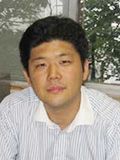
- Wataru Nakao(Professor, Yokohama National University, Faculty of Engineering)
- Advanced Low Carbon Technology Research and Development Program, ALCA
- Innovative Light-Weight Materials for the Energy-Efficient Society
“Development of the Novel Ceramics having Self-Healing Function for Turbine Blade” R & D Project leader(2012-2019)
60,000 times increase of reaction speed by the addition of manganese oxide
In the aircraft industry, reducing the weight of aircraft and improving the efficiency of engines for the reduction of exhausted carbon-dioxide (CO2) gas are important challenges to prevent global warming. Professor Wataru Nakao, R & D Project leader of one of ALCA projects, and his group elucidated the repair mechanism of materials called “self-healing ceramics” in a joint study with National Institute for Materials Science. Furthermore, by adding manganese oxides, they succeeded in repairing cracks with a reaction speed 60,000 times faster than the conventional method. They say that if light and durable ceramics could replace the jet engine of aircraft, about 15% improvement in fuel efficiency can be expected.
When the research group examined the crack repair, they discovered that the self-healing ceramics undergo three healing stages: inflammation, repair, and modification, as in bone healing. The mechanism is that when the ceramics crack, oxygen intruding from the crack reacts with silicon carbide (self-healing agent) and synthesizes silicon dioxide [inflammation]. Aluminum oxide (alumina), the raw material of ceramics, and silicon dioxide react to fill the crack [repair], and the strength is recovered through crystallization [modification].
With the elucidation of the healing mechanism, we also discovered that manganese oxides is extremely useful as a new material to significantly accelerate the reaction speed of repair and modification. Getting a hint from a body fluid network that promotes bone healing, manganese oxide, which activate the healing of ceramics, was placed at the grain boundary. In this manner, at 1,000°C where aircraft engine operates, cracks were repaired at a fastest speed of one minute while it previously took 1,000 hours.
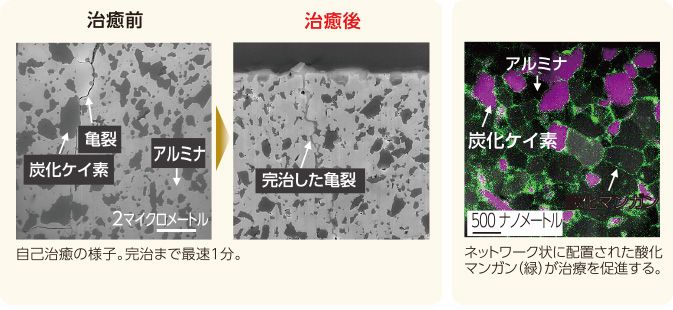
Healing time is extremely reduced with the addition of manganese oxide.
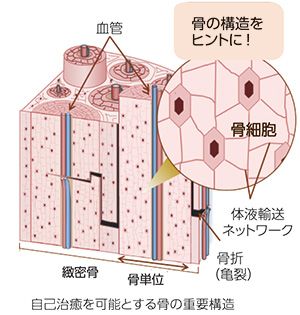
Hinted from the bone structure! Active-phase arrangement method
Fragile and inadequate for practical use
If the material of jet engine could be changed from nickel alloy (presently used) to ceramics with only ¼ specific gravity, significant reduction in weight can be achieved. As a result, reduction of CO2 emission can be expected. Ceramics are also strong at high temperature and resistant to corrosion. Additionally, due to low thermal conductivity, energy conversion efficiency is high. If turbine blades of jet engines in aircraft could be replaced by ceramics, fuel efficiency is estimated to improve by about 15%. However, because it also has a property of being fragile and vulnerable to impact, it has not been put to practical use yet.
As a consequence, what draws attention is the self-healing ceramics that repair cracks by themselves. Self-healing ceramics are composed of oxides such as alumina, which is a base material of ceramics, and “self-healing agent” such as silicon carbide that develops a self-healing function. Since its development in 1995, it has been expected worldwide as a light heat-resistant material for aircraft engine turbine components. However, since the mechanism of self-healing is still unclear, and the healing ability is weak, improvement of performance has been desired.
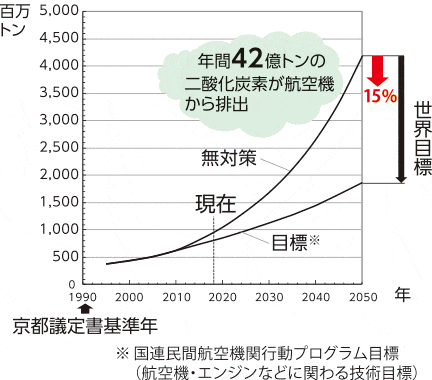
CO2 emissions of passenger aircraft in the overall international aviation sector
Succeeded in self-healing function with continuous fibers, but within narrow temperature range for self-healing performance
Professor Nakao has successfully developed “Continuous-fiber-reinforced self-healing ceramics” with high repair ability in 2014. The surface of the elongated fibrous ceramics bundle are coated with silicon carbide, covering it with ceramic powder (base material), and then sintering it.
The point is that generally the SiC interlayer has large stiffness gap compared to ceramics fiber bundle. When impacted from the outside, cracks would be guided from the matrix toward the surface of silicon carbide. At high temperature environment oxygen is introduced via clack to SiC surface, and oxidize SiC to silicon dioxide (SiO2). The formed SiO2 fill the crack and repair as self-healing phenomenon. Furthermore, the repaired area will show equal to or higher strength than the area before the cracks were developed. This is similar to the fact that when bone fracture is healed, the area has higher strength than areas that have not been fractured. In other words, it has an innovative nature by self-healing mechanism. That is to say that repeating crack formation to repairing cycles in long term using at high temperature causes increasing of strength as the self-healing phenomenon.
However, since this continuous-fiber-reinforced self-healing ceramics can only repair cracks in a limited range of temperature (1200–1300˚C), therefore, for practical use, the self-healing temperature range needs to be extended by thorough examination of the self-healing mechanism. To solve the problems mentioned above, Professor Nakao's group developed new self-healing technology which was mentioned at the beginning. By adding small amount of manganese oxide, they succeeded simultaneously to be lower self-healing temperature and to shorten the repairing time drastically.
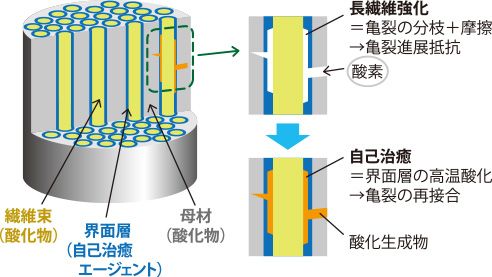
Schematic diagram of continuous-fiber-reinforced self-healing ceramics
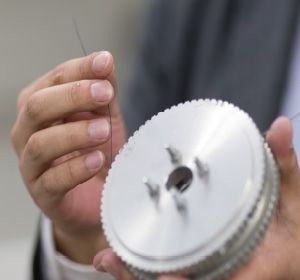
Photograph of raw material for continuous-fiber-reinforced self-healing ceramics
(Aluminum oxide fiber bundles coated with silicon carbide with self-healing function)
Developing of jet engines elements
If the result of this study is put to practical use, not only will it be possible to realize lighter and more efficient engines for transport system such as aircraft and automobiles, but a paradigm shift can occur such as in design specification and service life of parts. Professor Nakao said that they would continue our study and development of ceramics applicable to jet engine parts with a high level of reliability through the self-healing function. By learning not only from healing of bones but also from toughening structures, Professor Nakao also hopes to develop ceramics that “does not break even if cracked” and ultimately can “live with the damages” under the environment used.
At the same time, Professor Nakao plans to promote database maintenance necessary to accelerate their practical use in the industry, and develop a computing platform that can predict the rate of healing from composition, system, and the condition of use. In the future, by developing Japan's unique light and heat-resistant materials, Professor Nakao hopes to contribute to about 15% reduction in CO2 emissions from the global aviation industry.
- Environment and Energy
- Research Results
- Japanese
